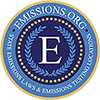Emission testing is an essential, often mandatory, component of responsible vehicle ownership.
Beyond its regulatory requirements, it assumes a pivotal role in upholding environmental accountability and safeguarding the air we breathe.
For conscientious individuals committed to minimizing their ecological impact, emission testing transcends a mere formality—it stands as a tangible effort toward curbing emissions, reducing one’s carbon footprint, and fostering a healthier environment.

Understanding Emission Testing
Emission testing, also known as smog testing, is a vital process that measures the pollutants emitted by your vehicle. It plays a crucial role in environmental protection and ensuring that our vehicles meet stringent emissions standards.
Emission Testing Basics
Emission testing, often called smog testing, is a straightforward process that checks the pollutants your vehicle releases into the air. State environmental agencies have established strict standards for emissions, and the test’s main job is to make sure vehicles follow these rules.
Why Emission Testing Matters
Emission testing matters a lot because it directly affects the air we breathe and the health of our environment.
- Air Quality: Passing the test means fewer harmful pollutants in the air we all breathe, making it cleaner and safer.
- Public Health: Lower emissions contribute to better public health by reducing the risk of respiratory problems and other illnesses.
- Environmental Protection: It’s a critical step in protecting our environment, reducing our carbon footprint, and fighting climate change.
The Emission Testing Process
Before you head to the testing center, a few straightforward preparations can significantly enhance your chances of passing the test. These simple yet crucial steps can make a difference in ensuring your vehicle meets emissions standards effectively.
Check Your Vehicle Manual
Your vehicle’s manual holds key insights into its emission system and maintenance requirements, guiding you toward emission test success.
- Know Your Components: Your manual helps you identify vital emission components like the catalytic converter and oxygen sensor.
- Maintenance Guidance: It provides maintenance schedules and recommendations, ensuring you stay on top of emission-related upkeep.
Resolve Any Warning Lights
Addressing illuminated warning lights, especially the ‘Check Engine’ light, is vital in preparing your vehicle for a successful emission test.
- Diagnostic Clues: Warning lights provide early clues about potential emission problems, allowing you to address them before the test.
- Avoid Test Failure: Resolving issues behind warning lights can prevent test failure and associated hassles.
Proper Tire Inflation
Ensuring your tires are properly inflated may seem unrelated, but it can affect emissions readings. Here’s how:
- Optimal Combustion: Properly inflated tires help your vehicle’s engine operate efficiently, leading to better combustion and reduced emissions.
- Accurate Readings: Correct tire pressure contributes to accurate emissions readings during the test.
Use Fuel Additives
Consider using fuel additives designed to clean your engine and improve fuel efficiency, which can lead to lower emissions. Here’s how this can help:
- Engine Cleanliness: Fuel additives can clean carbon deposits from your engine, promoting smoother operation and lower emissions.
- Enhanced Fuel Efficiency: Improved fuel efficiency means you burn less fuel, reducing emissions as a result.
Preparing your vehicle with these simple steps can increase the likelihood of a successful emission test, contributing to cleaner air and a healthier environment.
What to Expect During the Test
Understanding the emission testing process is crucial. Here, we detail the steps involved in ensuring your vehicle meets state emissions regulations effectively.
Tailpipe Test
The tailpipe test is a vital part of emission testing. Let’s explore how it works and why it’s crucial for assessing vehicle emissions.
- A probe is inserted into your vehicle’s tailpipe to measure the emissions directly.
- This measures the gasses your vehicle releases, like carbon monoxide and hydrocarbons.
- The results are compared to set limits to determine if your vehicle passes or fails.
Onboard Diagnostics (OBD) Test
Delve into the world of OBD testing, a critical component of emission tests, and discover its role in assessing your vehicle’s emissions.
- This checks your vehicle’s computer system for emission-related issues and error codes.
- Technicians use specialized equipment to connect to your vehicle’s OBD system.
- It monitors your engine’s performance and can detect problems like malfunctioning sensors or misfires.
Visual Inspection
Explore the significance of visual inspections in emission testing, uncovering how they ensure the integrity of your vehicle’s emission control components.
- A technician may visually inspect your emission control components for signs of tampering or damage.
- They check parts like the catalytic converter and muffler for proper installation and condition.
- This step ensures that your vehicle’s emission control systems are intact and functioning as they should.
These three components of the emission test are designed to assess your vehicle’s emissions comprehensively, ensuring that it meets the required environmental standards set by your state.
Importance of Passing an Emission Test
Emission testing is not merely a regulatory hurdle—it has far-reaching implications for both the environment and vehicle owners.
Environmental Benefits
Lower vehicle emissions contribute to improved air quality, reducing the risk of respiratory issues and environmental damage, aligning with eco-conscious values.
Cleaner Air: Lower vehicle emissions contribute to improved air quality, reducing the risk of respiratory issues and environmental damage. Breathing cleaner air is healthier for everyone.
Combatting Climate Change: Fewer emissions mean a smaller carbon footprint, aligning with your eco-conscious values. It’s an active step in protecting our planet for future generations.
Legal Requirements and Consequences
Compliance with emission regulations is essential, avoiding penalties and maintaining good standing with authorities. Understand the legal aspects of emission testing.
Avoiding Penalties: Failure to pass an emission test can result in fines and penalties, which can be a significant financial burden. Passing the test helps you avoid these financial setbacks.
Maintaining Compliance: Complying with emission regulations ensures you’re on the right side of the law. It’s a legal requirement that keeps you in good standing with authorities.
Insurance and Registration Implications
Explore the significance of passing the emission test concerning vehicle registration and insurance coverage. Ensure your vehicle remains road-legal.
Renew Your Registration: Passing the emission test is often a requirement to renew your vehicle registration. It’s a necessary step in keeping your vehicle road-legal.
Insurance Coverage: Some insurance providers may require proof of emission test compliance to maintain coverage. Passing the test can help you retain insurance benefits.
By passing an emission test, you not only contribute to a cleaner environment and public health but also stay in compliance with the law, avoid financial penalties, and ensure the continued operation of your vehicle.
Tips for a Successful Emission Test
Emission tests play a significant role in ensuring our vehicles operate cleanly and efficiently. Passing these tests is not as daunting as it may seem; with some preparation, you can increase your chances of success.
Regular Vehicle Maintenance
- Regular Oil Changes: Clean oil helps reduce emissions. Change your oil as recommended in your vehicle’s manual.
- Air Filter Replacement: A clean air filter ensures proper airflow to the engine, improving combustion efficiency.
- Spark Plug Inspection: Worn spark plugs can affect combustion efficiency and increase emissions. Replace them if necessary.
Use Quality Fuel and Additives
- Choose Cleaner Fuel Options: Consider using higher-octane or ethanol-free fuel to reduce emissions.
- Fuel Additives: Some additives can clean your engine and fuel system, leading to lower emissions. Follow the manufacturer’s recommendations.
Drive Your Vehicle Smartly
- Smooth Acceleration and Braking: Avoid aggressive driving, which can increase emissions. Drive steadily and maintain a consistent speed.
- Reduce Idling: Turn off your engine when parked for extended periods. Idling consumes fuel unnecessarily.
Address Warning Lights and Codes
- Diagnostic Trouble Codes (DTCs): If your vehicle has DTCs, get them resolved promptly to avoid test failure. A mechanic can diagnose and fix these issues.
Invest in Professional Inspections
- Professional Inspection: Consider having your vehicle inspected by a certified mechanic before the test. They can identify and fix issues that may cause test failure.
By following these tips, you can not only increase your chances of passing the emission test but also contribute to a cleaner environment and more efficient vehicle operation.
Finding an Emission Test Center Near You
To successfully complete your emission testing, locating a nearby testing center is crucial. Discover how to find one conveniently for a hassle-free testing experience.
Utilizing Online Resources
Harness the power of the internet to locate emission testing centers near you effortlessly. Online tools simplify your testing center search for added convenience.
- Online Tools: Use websites and online tools that allow you to search for the nearest testing center by entering your zip code.
- Convenience: Online resources provide quick access to testing center locations, saving you time and effort in your search.
Contacting Local Authorities
Tap into the expertise of your local Department of Motor Vehicles (DMV) or environmental agency for precise information on emission testing centers.
- Local DMV or Environmental Agency: Reach out to your local Department of Motor Vehicles (DMV) or environmental agency for information on testing center locations and requirements.
- Official Guidance: Local authorities can provide accurate and up-to-date information, ensuring you have the right details.
Planning Your Visit
Ensure a smooth and efficient experience at the emission testing center by organizing necessary documents, fees, and your vehicle’s registration ahead of time.
- Gather Necessary Documents: Before heading to the testing center, make sure you have all the required documents, including your vehicle’s registration and any testing fees.
- Be Prepared: Being organized ensures a smooth testing experience and prevents unnecessary delays.
Take Action for a Greener Tomorrow
Passing an emission test isn’t just about complying with regulations; it’s a commitment to a cleaner environment and a healthier future. By following the expert tips outlined in this guide, you can not only ensure your vehicle’s compliance but also reduce your carbon footprint and contribute to cleaner air. Your efforts in emission testing contribute to a more eco-conscious and sustainable tomorrow for all.

No comment yet, add your voice below!